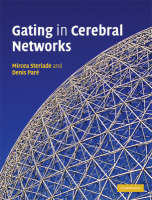
Gating in Cerebral Networks
Seiten
2007
Cambridge University Press (Verlag)
978-0-521-85122-0 (ISBN)
Cambridge University Press (Verlag)
978-0-521-85122-0 (ISBN)
The correct functioning of the mammalian brain depends on the co-ordinated activity of many different parts - from cells to systems. How these component parts interact determines various behaviours and outcomes. The authors describe how these interactions work in both normal conditions and in diseased states.
The correct functioning of the mammalian brain depends on the integrated activity of myriad neuronal and non-neuronal cells. Discrete areas serve discrete functions, and dispersed or distributed communities of cells serve others. Throughout, these networks of activity are under the control of neuromodulatory systems. One goal of current neuroscientific research is to elucidate the precise methods by which these systems operate, especially during normal conscious behaviours and processes. Mircea Steriade and Denis Paré describe the neuronal properties and networks that exist within and between the cortex and two important sub-cortical structures: the thalamus and amygdala. The authors explore the changes in these properties, covering topics including morphology, electrophysiology, architecture and gating; and comparing regions and systems in both normal and diseased states. Aimed at graduates and postdoctoral researchers in neuroscience.
The correct functioning of the mammalian brain depends on the integrated activity of myriad neuronal and non-neuronal cells. Discrete areas serve discrete functions, and dispersed or distributed communities of cells serve others. Throughout, these networks of activity are under the control of neuromodulatory systems. One goal of current neuroscientific research is to elucidate the precise methods by which these systems operate, especially during normal conscious behaviours and processes. Mircea Steriade and Denis Paré describe the neuronal properties and networks that exist within and between the cortex and two important sub-cortical structures: the thalamus and amygdala. The authors explore the changes in these properties, covering topics including morphology, electrophysiology, architecture and gating; and comparing regions and systems in both normal and diseased states. Aimed at graduates and postdoctoral researchers in neuroscience.
1. Morphology and properties of neurons in the thalmus; 2. Architecture and electrophysiology of neocortical cells; 3. Amygdala; 4. Rhinal and medial prefrontal cortices; 5. Neuromodulation and state-dependent activities in forebrain neuronal circuits; 6. Gating of signals in brain-disconnected slow-wave sleep; 7. Neuronal processes and cognitive functions in brain-active states of waking and REM sleep; 8. Comparison of state-dependent activity patterns in the thalamocortical, hippocampal and amygdalocortical systems; 9. Neuronal substrates of some mental disorders.
| Erscheint lt. Verlag | 13.9.2007 |
|---|---|
| Zusatzinfo | 8 Plates, color; 22 Halftones, unspecified; 95 Line drawings, unspecified |
| Verlagsort | Cambridge |
| Sprache | englisch |
| Maße | 195 x 257 mm |
| Gewicht | 912 g |
| Themenwelt | Naturwissenschaften ► Biologie ► Humanbiologie |
| Naturwissenschaften ► Biologie ► Zoologie | |
| ISBN-10 | 0-521-85122-X / 052185122X |
| ISBN-13 | 978-0-521-85122-0 / 9780521851220 |
| Zustand | Neuware |
| Haben Sie eine Frage zum Produkt? |
Mehr entdecken
aus dem Bereich
aus dem Bereich
23 Techniken, um Stress abzubauen, Negativspiralen zu unterbrechen …
Buch | Softcover (2023)
FinanzBuch Verlag
CHF 25,20
produktiv sein ohne Stress – und mehr vom Leben haben
Buch | Softcover (2023)
dtv Verlagsgesellschaft
CHF 25,20
Veränderungen gehirngerecht gestalten
Buch | Softcover (2024)
Haufe (Verlag)
CHF 76,95


